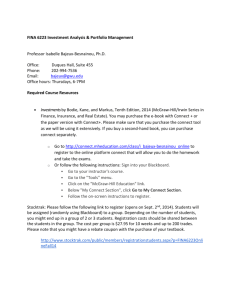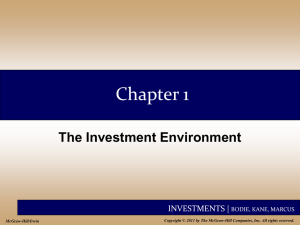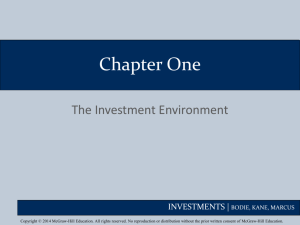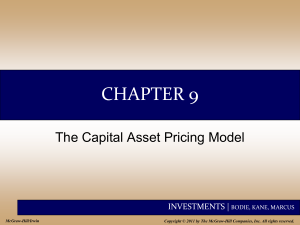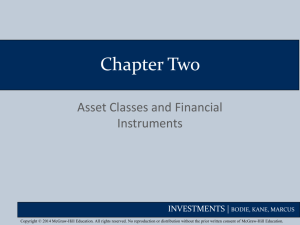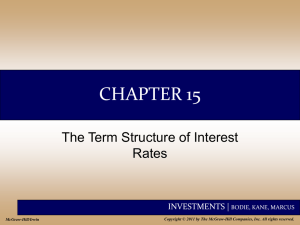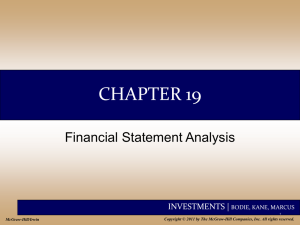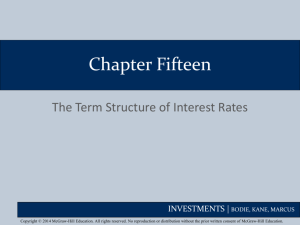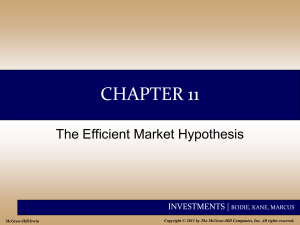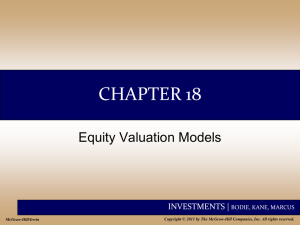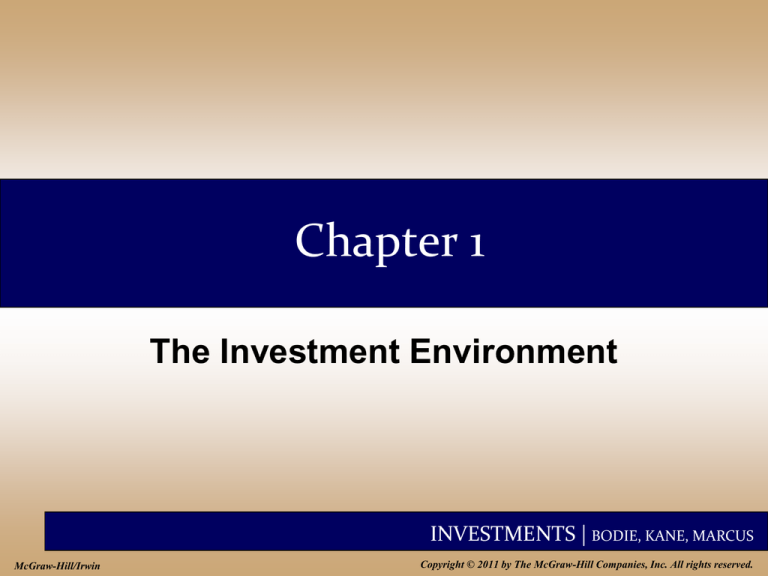
Chapter 1
The Investment Environment
INVESTMENTS | BODIE, KANE, MARCUS
McGraw-Hill/Irwin
Copyright © 2011 by The McGraw-Hill Companies, Inc. All rights reserved.
1-2
Real Assets Versus Financial Assets
• Real Assets
– Determine the productive capacity and
net income of the economy
– Examples: Land, buildings, machines,
knowledge used to produce goods and
services
• Financial Assets
– Claims on real assets
INVESTMENTS | BODIE, KANE, MARCUS
1-3
Financial Assets
• Three types:
1. Fixed income or debt
2. Common stock or equity
3. Derivative securities
INVESTMENTS | BODIE, KANE, MARCUS
1-4
Fixed Income
• Payments fixed or determined by a
formula
• Money market debt: short term, highly
marketable, usually low credit risk
• Capital market debt: long term bonds,
can be safe or risky
INVESTMENTS | BODIE, KANE, MARCUS
1-5
Common Stock and Derivatives
• Common Stock is equity or ownership
in a corporation.
– Payments to stockholders are not fixed,
but depend on the success of the firm
• Derivatives
– Value derives from prices of other
securities, such as stocks and bonds
– Used to transfer risk
INVESTMENTS | BODIE, KANE, MARCUS
1-6
Financial Markets and the Economy
• Information Role: Capital flows to
companies with best prospects
• Consumption Timing: Use securities
to store wealth and transfer
consumption to the future
INVESTMENTS | BODIE, KANE, MARCUS
1-7
Financial Markets and the
Economy (Ctd.)
• Allocation of Risk: Investors can select
securities consistent with their tastes
for risk
• Separation of Ownership and
Management: With stability comes
agency problems
INVESTMENTS | BODIE, KANE, MARCUS
1-8
Financial Markets and the
Economy (Ctd.)
• Corporate Governance and Corporate Ethics
– Accounting Scandals
• Examples – Enron, Rite Aid, HealthSouth
– Auditors – watchdogs of the firms
– Analyst Scandals
• Arthur Andersen
– Sarbanes-Oxley Act
• Tighten the rules of corporate governance
INVESTMENTS | BODIE, KANE, MARCUS
1-9
The Investment Process
• Asset allocation
– Choice among broad asset classes
• Security selection
– Choice of which securities to hold within
asset class
– Security analysis to value securities and
determine investment attractiveness
INVESTMENTS | BODIE, KANE, MARCUS
1-10
Markets are Competitive
• Risk-Return Trade-Off
• Efficient Markets
– Active Management
• Finding mispriced securities
• Timing the market
INVESTMENTS | BODIE, KANE, MARCUS
1-11
Markets are Competitive (Ctd.)
– Passive Management
• No attempt to find undervalued
securities
• No attempt to time the market
• Holding a highly diversified portfolio
INVESTMENTS | BODIE, KANE, MARCUS
1-12
The Players
• Business Firms– net borrowers
• Households – net savers
• Governments – can be both borrowers
and savers
INVESTMENTS | BODIE, KANE, MARCUS
1-13
The Players (Ctd.)
• Financial Intermediaries: Pool and invest
funds
– Investment Companies
– Banks
– Insurance companies
– Credit unions
INVESTMENTS | BODIE, KANE, MARCUS
1-14
Universal Bank Activities
Investment Banking
• Underwrite new stock
and bond issues
• Sell newly issued
securities to public in
the primary market
• Investors trade
previously issued
securities among
themselves in the
secondary markets
Commercial Banking
• Take deposits and
make loans
INVESTMENTS | BODIE, KANE, MARCUS
1-15
Financial Crisis of 2008
• Antecedents of the Crisis:
– “The Great Moderation”: a time in which the
U.S. had a stable economy with low interest
rates and a tame business cycle with only
mild recessions
– Historic boom in housing market
INVESTMENTS | BODIE, KANE, MARCUS
1-16
Figure 1.3 The Case-Shiller Index of
U.S. Housing Prices
INVESTMENTS | BODIE, KANE, MARCUS
1-17
Changes in Housing Finance
Old Way
New Way
• Local thrift institution
made mortgage loans to
homeowners
• Thrift’s major asset: a
portfolio of long-term
mortgage loans
• Thrift’s main liability:
deposits
• “Originate to hold”
• Securitization: Fannie
Mae and Freddie Mac
bought mortgage loans
and bundled them into
large pools
• Mortgage-backed
securities are tradable
claims against the
underlying mortgage pool
• “Originate to distribute”
INVESTMENTS | BODIE, KANE, MARCUS
1-18
Figure 1.4 Cash Flows in a Mortgage
Pass-Through Security
INVESTMENTS | BODIE, KANE, MARCUS
1-19
Changes in Housing Finance
(Ctd.)
• At first, Fannie Mae and Freddie Mac
securitized conforming mortgages, which
were lower risk and properly documented.
• Later, private firms began securitizing
nonconforming “subprime” loans with
higher default risk.
– Little due diligence
– Placed higher default risk on investors
– Greater use of ARMs and “piggyback” loans
INVESTMENTS | BODIE, KANE, MARCUS
1-20
Mortgage Derivatives
• Collateralized debt obligations (CDOs)
– Mortgage pool divided into slices or tranches
to concentrate default risk
– Senior tranches: Lower risk, highest rating
– Junior tranches: High risk, low or junk rating
INVESTMENTS | BODIE, KANE, MARCUS
1-21
Mortgage Derivatives
• Problem: Ratings were wrong! Risk was
much higher than anticipated, even for the
senior tranches
INVESTMENTS | BODIE, KANE, MARCUS
1-22
Why was Credit Risk
Underestimated?
• No one expected the entire housing
market to collapse all at once
• Geographic diversification did not
reduce risk as much as anticipated
• Agency problems with rating agencies
• Credit Default Swaps (CDS) did not
reduce risk as anticipated
INVESTMENTS | BODIE, KANE, MARCUS
1-23
Credit Default Swap (CDS)
• A CDS is an insurance contract against
the default of the borrower
• Investors bought sub-prime loans and
used CDS to insure their safety
INVESTMENTS | BODIE, KANE, MARCUS
1-24
Credit Default Swap (CDS)
• Some big swap issuers did not have
enough capital to back their CDS when the
market collapsed.
• Consequence: CDO insurance failed
INVESTMENTS | BODIE, KANE, MARCUS
1-25
Rise of Systemic Risk
• Systemic Risk: a potential breakdown of the
financial system in which problems in one
market spill over and disrupt others.
– One default may set off a chain of further
defaults
– Waves of selling may occur in a downward
spiral as asset prices drop
– Potential contagion from institution to
institution, and from market to market
INVESTMENTS | BODIE, KANE, MARCUS
1-26
Rise of Systemic Risk (Ctd.)
• Banks had a mismatch between the
maturity and liquidity of their assets and
liabilities.
– Liabilities were short and liquid
– Assets were long and illiquid
– Constant need to refinance the asset portfolio
• Banks were very highly levered, giving
them almost no margin of safety.
INVESTMENTS | BODIE, KANE, MARCUS
1-27
Rise of Systemic Risk (Ctd.)
• Investors relied too much on “credit
enhancement” through structured
products like CDS
• CDS traded mostly “over the counter”,
so less transparent, no posted margin
requirements
• Opaque linkages between financial
instruments and institutions
INVESTMENTS | BODIE, KANE, MARCUS
1-28
The Shoe Drops
• 2000-2006: Sharp increase in housing
prices caused many investors to believe
that continually rising home prices would
bail out poorly performing loans
• 2004: Interest rates began rising
• 2006: Home prices peaked
INVESTMENTS | BODIE, KANE, MARCUS
1-29
The Shoe Drops
• 2007: Housing defaults and losses on
mortgage-backed securities surged
• 2007: Bear Stearns announces trouble at
its subprime mortgage–related hedge
funds
INVESTMENTS | BODIE, KANE, MARCUS
1-30
The Shoe Drops
• 2008: Troubled firms include Bear
Stearns, Fannie Mae, Freddie Mac, Merrill
Lynch, Lehman Brothers, and AIG
– Money market breaks down
– Credit markets freeze up
– Federal bailout to stabilize financial system
INVESTMENTS | BODIE, KANE, MARCUS
1-31
Systemic Risk and the Real Economy
• Add liquidity to reduce insolvency risk and
break a vicious circle of valuation
risk/counterparty risk/liquidity risk
• Increase transparency of structured
products like CDS contracts
• Change incentives to discourage
excessive risk-taking and to reduce
agency problems at rating agencies
INVESTMENTS | BODIE, KANE, MARCUS

